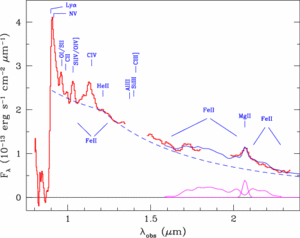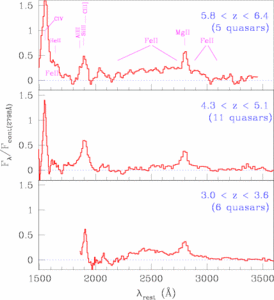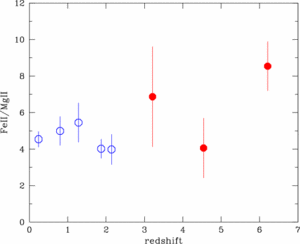TNG casts new light on star formation and chemical evolution at high redshifts (z>6)
NICS-Amici, the very low resolution spectroscopic mode of the TNG IR instrument , has once more proved its unique capabilities by producing the by far most complete sample of IR spectra of high redshift quasars, including those at z>6 recently discovered by the SLOAN project.

Fig. 1 Red line: NICS-Amici spectrum of the farthest QSO known at z=6.4
The blue-dashed line shows
the fit to the continuum emission.
These data, whose quality match and often exceeds those of similar spectra taken on 8-10m class telescopes, have unambiguously demonstrated that the prominent emission feature produced by singly ionized iron (FeII) are very strong in basically all quasars, thus indicating that large abundances of iron were already present even at the earliest phase of the universe which we can presently study.

Fig. 2 Average quasar spectra (residual after continuum subtraction) around the
FeII lines
obtained by grouping the objects by redshift bins.
Once interpreted as abundance measurements, the relative intensities of the FeII and MgII lines can be used to constrain the star formation history at early epochs. The finding that FeII/MgII remains constant, or even increases, up to z~6 (Fig.3) implies that a major episode of star formation occurred at z>9 in the host galaxies of these high redshift QSO, possibly corresponding to the epoch of re-ionization.

Fig. 3 Filled-red symbols: redshift variation of FeII/MgII ratio
bins for the sample of QSO observed at TNG.
Hollow-blue symbols are the values for lower redshift QSO from
Dietrich et al. (2003).
A more detailed analysis and discussion can be found in Maiolino et al. 2003, ApJL in press (astro-ph/0307264).

